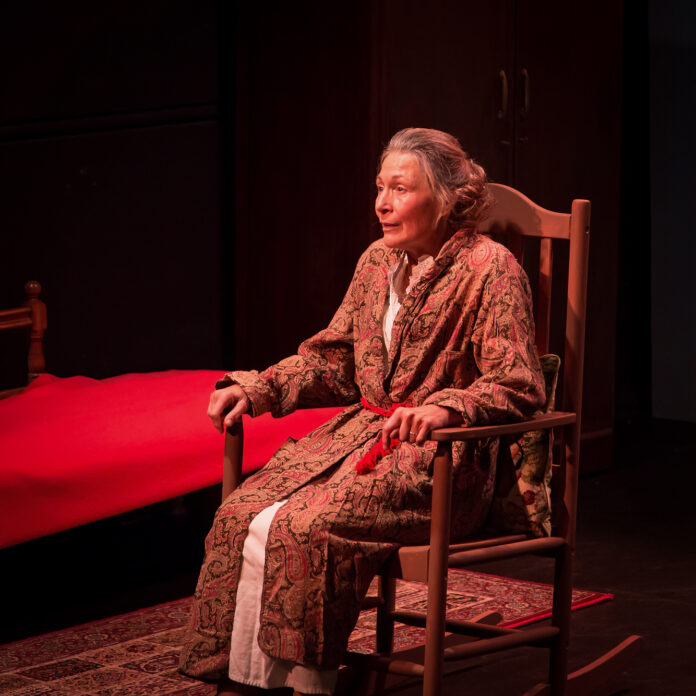Libby Drake’s Director’s Notes state that “many Red Phoenix plays have been pretty gritty and we thought it was time to balance our programme with a gentler play that all audience members should be able to relate to in some way.” It is arguable whether Horton Foote’s “The Trip to Bountiful” is any ‘gentler’, and this reviewer found it to be as disturbing and deeply thought provoking as many other productions by Red Phoenix.
Red Phoenix pride themselves in producing “…only Adelaide premieres”, and “The Trip to Bountiful” continues that mission. The play first premièred in March 1953 on NBC-TV before going to Broadway for a relatively short run later that year. The play became better known when it was adapted for a critically acclaimed film to in 1985 (with screenplay by the playwright), and revived on Broadway in 2013, which was nominated for prestigious various awards.
The plot is quite simple. Carrie Watts (played by Sharon Malujlo) is an elderly woman who lives with her son Ludie (Leighton Vogt) and daughter in law Jessie Mae (Krystal Cave) in a small one-bedroom apartment in Houston, Texas. Carrie’s circumstances are uncomfortable, unhappy and unfulfilling: she sleeps on a chaise in the dining room, while Ludie and Jessie Mae use the bedroom; she is de facto housekeeper; and she routinely hands over her pension cheque to Jessie Mae who uses the money to pander to her own vanities. Carrie is not in the best of health and longs to return to Bountiful, the town in which she was raised as a child, before she is no longer able to physically do so. She plans her ‘escape’ and makes the trip, which proves to be difficult. The journey is not uneventful, and in the end she discovers that Bountiful has suffered the same fate as other small country towns and is nothing but a shell of its former charm. Sadly, she learns that friends from her childhood have recently passed away. It is not a happy homecoming, and inevitably Ludie comes looking for her and, at Jessie Mae’s insistence, is taken back to Houston but with new and punitive house rules to be imposed.
Yes, the plot is simple, and the events that happen are prosaic, but it all happens under a gloomy and foreboding sadness. From the very opening scene it is clear to the audience that we are not in for a happy time, and that Carrie is somehow doomed to be plunged deeper into despair. No, it is not a “gentler play”, and, in less capable hands than Red Phoenix and the masterful Sharon Malujlo, the whole thing could have been a miserable theatrical experience.
Malujlo is an extraordinarily capable actor, and her ‘Carrie’ is sharply observed. Every adjective and adverb that other characters in the script use to describe Carrie have been carefully considered by Malujlo and embodied in her characterisation. There are a few moments of supreme tenderness and many of extreme anguish and pain. The audience sheds silent tears with her. One can almost feel Carrie’s arthritic joints as Malujlo moves around the stage with the studied gait of an old woman who refuses to give in as she clutches desperately onto her ever-waning independence. Quite simply, Malujlo’s performance is sublime, and the underlying theme of deriving comfort and consolation from the simple (or not so simple!) act of returning ‘home’ is made palpable through her substantial skill.
Kate Prescott’s set design is sparse and deliberately unattractive. It matches Carrie’s day-to-day life and the silent regret Ludie has at not being as successful in life as some of his friends. Indeed, life for him has been ‘unbountiful’ and mean, and Vogt portrays that in a manner that is sincere and unrelenting. Despite the apparent austerity of her physical world, Jessie Mae’s lot is seemingly more tolerable, and Cave gives her a distasteful air of contentment in the way she controls her physical environment and the various people she dominates. The audience quickly learns to dislike Jessie Mae, which is a compliment to Cave.
The cast is rounded out with a subtly nuanced performance from Laura Antoniazzi in the role of Thelma, and competent cameos from Brian Godfrey, Megan Dansie, Stuart Pearce and Ron Hoenig.
The action of the play is in a variety of diverse locations, including the Houston apartment, bus station waiting rooms, inside a bus, and the decaying former family home in Bountiful. Each change of scene was associated with substantial and time-consuming set changes, with wall screens and large furniture items being moved and carried about. On a larger stage (with actual wing space) these maneuvers would be less obtrusive, but … the set changes were choreographed with military precision and efficiency. Kudos to stage manager Jan Farr, who with director Libby Drake, also managed stage properties that had convincing authenticity as did the costuming and hair dressing. The overall impact was assisted by appropriate sound effects and complementary lighting.
The Trip to Bountiful is not a gentle night out at the theatre, but director Libby Drake has ensured it is a quality experience.



